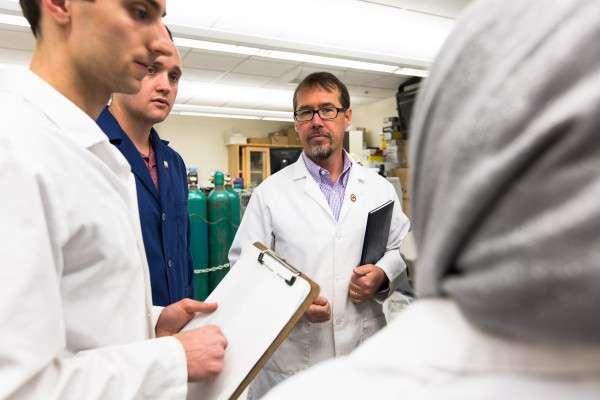NMSU researcher helps explore cost-effective, non-polluting enhanced geothermal systems

Tapping the natural heat of the earth may be more cost-effective and clean thanks to a research project led by researchers at Pacific Northwest National Laboratory in collaboration with New Mexico State University Assistant Professor Kenneth C. Carroll.
Carroll is a member of a group that has published two papers related to a new area of geothermal energy, called enhanced geothermal systems. These systems are designed to enable power production in areas where conventional geothermal techniques don't work.
The group, led by Carlos Fernandez, Ph.D., at PNNL, has developed a new fracturing fluid that uses an environmentally friendly polymer to create tiny cracks in bedrock deep below the surface of the earth. The cracks provide places for water to be pumped into the rock, a process called "reservoir stimulation." There, the heat of the earth – around 150-400 degrees Celsius at depths of 900-4,000 meters – is hot enough to turn the water to steam. The steam then can be returned to the surface and used as an energy source for power plants.
Unlike typical geothermal systems, which rely on porous rock, enhanced geothermal systems have much greater potential to tap the energy of geothermal hot spots in areas of otherwise impermeable bedrock.
The potential could be especially high in the western U.S., including New Mexico.
"The U.S. Geological Survey says most of the western U.S. has heat areas close to the surface," Carroll said. "New Mexico and most of the West has basin and range geology," characterized by narrow mountain ranges and flat basins or valleys. This often means heat sources in the earth are closer to the surface than in other areas, making geothermal development more practical.
The new fluid addresses some of the concerns about commonly used fracturing techniques used in the development of oil and gas. Those economically costly techniques require fluids and methods that generate unacceptable environmental impacts.
Carroll is part of a collaborative research project between the Pacific Northwest National Laboratory and NMSU.
"Our new fluid can make enhanced geothermal power production more viable," Carroll said. "And, though we designed the fluid for geothermal energy, it could also make unconventional oil and gas recovery more environmentally friendly."
The group's findings have been published by the Royal Society of Chemistry in the journal Green Chemistry, as well as by Elsevier in Geothermics, the International Journal of Geothermal Research and its Applications.
The project addresses some of the shortcomings of typical geothermal systems. In addition to the prospect of developing systems in areas of impermeable rock, enhanced geothermal systems also would not require that water already be present underground.
Because of the advantages, researchers see great potential for enhanced geothermal systems. Existing U.S. geothermal power plants generate up to 3.4 gigawatts of energy, making up about .4 percent of the nation's energy supply. A 2006 Massachusetts Institute of Technology report estimates enhanced geothermal systems could boost the nation's geothermal energy output to 100 gigawatts, enough to power 100 million American homes.
That potential has attracted the interest of the Department of Energy, which has funded five enhanced geothermal system demonstration projects in the U.S. At one project in Nevada, enhanced geothermal methods increased a conventional geothermal plant's productivity by 38 percent. However, technical challenges and concerns over cost and the amount of water used in these systems has limited their use.
Hydraulic fracturing processes, similar to those used in oil and gas production, also have been used in enhanced geothermal systems, but those processes have drawbacks due to the amount of water required, the potential toxicity of the chemicals used and the high costs of retrieving and treating the water.
In contrast, this novel fluid is a solution of water and 1 percent polyallylamine, a chemical made of carbon and nitrogen that is similar to polymers used in medicine. After it is pumped into a well at a geothermal hot spot, pressurized carbon dioxide is injected into the well. Within 20 seconds, a chemical reaction causes a hydrogel to form, expanding the fluid up to 2.5 times its original volume, expanding existing cracks in the rock and creating new ones. The process is expected to cut in half the amount of water and time needed to open up an underground reservoir, lowering the cost of power generation.
Researchers at PNNL are testing the fluid's performance on cylindrical samples of impermeable rock. The samples are placed inside a high-pressure, high-temperature test cell created by the researchers. Small amounts of the fluid and liquid carbon dioxide are injected into the test cell, then pressure and temperature are adjusted to match the conditions of the underground geothermal reservoirs.
The researchers found that the fluid consistently created small but effective cracks in the samples that allowed water to flow through. This led them to believe that larger scale tests might produce larger cracks.
The research team also expects that the fluid could be inexpensively recycled.
Additional studies are necessary to more thoroughly evaluate the fluid's performance. The team is planning lab studies to measure the level at which the fluid can be recycled as well as its ability to fracture larger pieces of rock. The ultimate goal is to conduct a controlled field test.
The research was funded by the Geothermal Technologies Office within DOE's Office of Energy Efficiency and Renewable Energy.
The team also is studying a similar fluid for unconventional oil and gas recovery.
"It would use a different polymer though the chemistry is similar to the one used in the geothermal energy extraction fluid," Fernandez said. The fluids are stable and can withstand extreme temperatures, pressures and acidity levels, unlike some fluids used in oil and gas recovery, which degrade over time. The new non-toxic, potentially recyclable fluid also would result in more efficient use of water.
Journal information: Green Chemistry
Provided by New Mexico State University




















